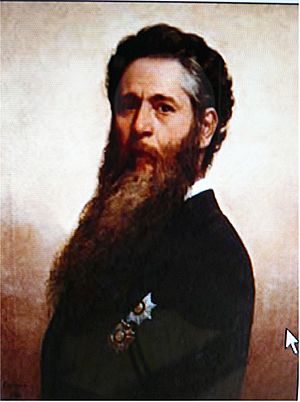Miguel Navarro Cañizares facts for kids
Quick facts for kids
Miguel Navarro Cañizares
|
|
|---|---|

Miguel Navarro Cañizares, Self-portrait, 1886
|
|
| Born | c. 1835 Valencia, Spain
|
| Died | 23 October 1913 |
| Nationality | Spanish |
| Education | Academy of Fine Arts, Valencia; San Fernando Academy, Madrid |
| Movement | Orientalist |
Miguel Navarro Cañizares (born around 1835 – died 1913) was a talented Spanish painter and art teacher. He spent much of his life working in countries like Venezuela and Brazil, sharing his art and teaching skills.
Biography
Miguel was born in Valencia, Spain. His father was a basket maker. He began his art journey at the Academy of Fine Arts in Valencia.
Later, he moved to Madrid. There, he took classes at the San Fernando Academy. He also worked in the studio of a famous artist named Federico de Madrazo. In 1861, Miguel tried to get a teaching job at a painting school, but he was not chosen.
Miguel often showed his paintings at the National Exhibition of Fine Arts in Spain. One of his paintings, showing Saint Catherine being carried by angels, won a gold medal! Another painting, about a brave woman named Agustina de Aragón, became very popular. It was even printed as a lithograph (a type of print) and used in a book. In 1864, he won a special award. This award allowed him to study art in Rome for his painting of the Raising of Jairus' daughter.
In 1871, the Archbishop of Caracas, Silvestre Guevara y Lira, saw Miguel's art. The Archbishop was at the First Vatican Council in Rome. He invited Miguel to paint murals in the Caracas Cathedral. However, this big project never happened.
Miguel arrived in Venezuela in 1872. This was shortly after President Antonio Guzmán Blanco had won an important battle. A newspaper editor suggested that Miguel, who was new and not involved in politics, would be perfect. He could paint the battle to remember the event. This huge painting hung in the Senate building until 1889. Then, it disappeared. It was likely destroyed by people who did not like the former President. They damaged his statues and portraits across the country.
His Career in Brazil
In 1876, Archbishop Guevara was removed from his position and had to leave the country. Miguel lost his supporter. He also might not have been welcome anymore. So, he quit his teaching job at the Academy of Fine Arts. He then moved to Rio de Janeiro with his wife and children.
However, an epidemic of yellow fever in Rio made him stop in Salvador. Soon, he found a job teaching at an art school there. But he was fired a year later. This was because he had big disagreements with the school's Director.
As a result, Miguel and some friends decided to start their own art academy. With help from an important person called the Baron de Lucena and the government, the new school opened just before Christmas that same year.
Even though the school was successful, Miguel could not earn enough money. There was not much demand for art in Salvador. So, after five years, he moved to Rio de Janeiro. There, he mainly worked as a portrait painter. Even the Royal family hired him to paint their portraits. He stayed in Rio until he passed away. Today, a street in the Pituba area of Salvador is named after him.
See also
 In Spanish: Miguel Navarro Cañizares para niños
In Spanish: Miguel Navarro Cañizares para niños


